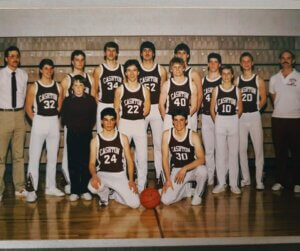Social Capital: Bonding and Bridging Equally Important
January 31, 2025
 | By Chad Dull, Chief Executive Officer |

Chad Dull (#22) formed deep, lifelong bonds with his basketball team from his youth.
How bonding and bridging shape stronger communities
When I was young, I loved to play basketball, and I was fortunate to develop a network of friends with my teammates. We all shared a love for the sport, for competing, and for just spending the tremendous amount of time together that team sports require. Many of us remain friends today, decades later.
We stay in touch in a variety of ways. All of us have gone on to build our own lives, families, and careers, but we have a bond built from those early connections and a shared sense of identity from our days as teammates. As the years have gone by, we have supported each other through marriages, the birth of children, the development of businesses and careers, and all the other milestones of life. Some of us have worked together on projects and stepped in to help when needed, personally and professionally.
Even when we go years without seeing each other, we feel a sense of connection to one another and willingness to look out for old teammates. This is the best example that comes to mind when I think of La Crosse Area Community Foundation’s guiding compass: social capital.
Bonding comes naturally
Social capital is simply explained as the benefits of being part of your social network. My aging teammates and I share a history that makes us likely to care for and support one another when we can. While we are not all the same, but we come from similar backgrounds. The connections with people who are mostly like you are referred to as “bonding” social capital and directly connect to the quality of our lives. Strong networks of bonding social capital make us feel safe and supported and give us tools to make our lives what we hope they will be.
Bridging takes more work.
But social capital is more than just bonding. It’s also about “bridging.” Bridging refers to forming connections outside our immediate circles and between diverse groups or individuals.
Bonding can be relatively effortless because spending time with people like ourselves is very easy. We tend to shop at the same places, have children in the same schools, attend the same events, etc.
Bridging, however, is a choice — one that pays endless benefits. Bridging expands our networks beyond our immediate circles, opening opportunities for growth, diversity, and resilience. While bonding social capital strengthens close relationships and fosters trust and mutual support within a group, bridging social capital connects you with individuals or groups outside your usual networks.
Bridging social capital gives us access to new resources and opportunities as a diverse network offers a broader range of solutions and insights. Different ways of thinking can lead to innovations that benefit us personally and collectively, especially as we work together to address community challenges and pool resources more effectively.
Bonding and Bridging combine for richer social capital.
Communities that balance bridging and bonding have social capital with depth and breadth, making them far more powerful for all to achieve personal, professional, and community goals.
And we know that communities with richer social capital simply do better. Health outcomes improve. Social and economic mobility improve, as well as all measures of well-being and happiness. Human beings are social creatures with a need for connection to thrive, and in this age of increasing disconnection, we need to find ways to build bonds and bridges.
Proximity matters
Much of my career has been focused on anti-poverty work, and one of the key concepts I have taught for years is the idea that proximity matters. Proximity matters in bonding and bridging because physical or social closeness facilitates easier interactions, trust-building, and shared experiences essential for strengthening bonds within groups (bonding) and creating meaningful connections across different groups (bridging).
How do you stay in proximity to the reality of the people you care about? Today it could be as simple as picking up the phone and asking the friend you only see on Facebook to coffee. Or you could look for an event in the community you have never attended before and take the brave step of showing up. It might look like volunteering for a cause you care about and meeting others who feel the same, as well as the people served by the cause.
Proximity to others’ stories is powerful and helps give our lives meaning and purpose. Our neighbors and our world need us to build bonds and bridges more than ever. We need to build social capital across dimensions of difference so we can all share a thriving community in this place we love so much.
To find ideas for building social capital — both bonding and bridging — visit our Building Social Capital Challenge.
